Applying Microbial Source Tracking Techniques for Identification of Pathways of Faecal Pollution from Water Sources to Point of Use in Vhembe District, South Africa
Abstract
1. Introduction
2. Materials and Methods
2.1. Study Design
2.2. Study Site and Population Description
2.3. Scientific Ethics Clearance and Informed Consent
2.4. Collection of Water Samples from Different Sources
2.5. Microbial Water Quality Analysis
2.5.1. Detection and Enumeration of E. coli
2.5.2. Detection of Faecal Sources of Contamination in Water Sources Using Host-Specific Bacteroidales qPCR Genetic Markers
Sample Preparation and Genomic DNA Extraction
2.5.3. Tracking and Detection of Sources of Faecal Contamination by Host-Specific Bacteroidales Genetic Markers Using qPCR
Validation of Bacteroidales Genetic Marker Assays in the Study Area
2.5.4. Standard Curves for Performance and Interpretation of qPCR Results
2.5.5. Data and Statistical Analysis
3. Results
3.1. Microbiological Quality Assessment of Water Samples
3.1.1. Detected E. coli Concentrations in Different Water Sources
3.1.2. Quality Assurance and Validation of MST Marker Assays
3.2. Prevalence of Sources of Contamination Detected in Study Villages
Prevalence of Detected Host-Specific Bacteroidales Gene Markers in Water Sources Used in the Target Study Villages
3.3. Relationship between E. coli Concentrations and Detected MST Markers
3.4. Distribution and Transmission Pathways of Sources of Contamination between Water Sources and Point of Use per Village
4. Discussion
5. Conclusions
Author Contributions
Funding
Data Availability Statement
Acknowledgments
Conflicts of Interest
References
- Dungumaro, E.W. Socioeconomic differentials and availability of domestic water in South Africa. Phys. Chem. Earth (Parts A/B/C) 2007, 32, 1141–1147. [Google Scholar] [CrossRef]
- World Health Organization (WHO). Water, Sanitation, Hygiene and Health: A Primer for Health Professionals (No. WHO/CED/PHE/WSH/19.149); World Health Organization: Geneva, Switzerland, 2019. [Google Scholar]
- Shahra, E.Q.; Wu, W. Water contaminants detection using sensor placement approach in smart water networks. J. Ambient Intell. Humaniz. Comput. 2020, 14, 4971–4986. [Google Scholar] [CrossRef]
- Bernhard, A.E.; Field, K.G. Identification of nonpoint sources of fecal pollution in coastal waters by using host-specific 16S ribosomal DNA genetic markers from fecal anaerobes. Appl. Environ. Microbiol. 2000, 66, 1587–1594. [Google Scholar] [CrossRef] [PubMed]
- Crookes, C.; Hedden, S.; Donnenfeld, Z. A delicate balance: Water scarcity in South Africa. ISS S. Afr. Rep. 2018, 2018, 1–24. Available online: https://www.wrc.org.za/wp-content/uploads/mdocs/ISS_A%20delicate%20balance.pdf (accessed on 14 May 2023).
- Harwood, V.J.; Staley, C.; Badgley, B.D.; Borges, K.; Korajkic, A. Microbial source tracking markers for detection of fecal contamination in environmental waters: Relationships between pathogens and human health outcomes. FEMS Microbiol. Rev. 2014, 38, 1–40. [Google Scholar] [CrossRef] [PubMed]
- Hinojosa, J.; Green, J.; Estrada, F.; Herrera, J.; Mata, T.; Phan, D.; Pasha, A.T.; Matta, A.; Johnson, D.; Kapoor, V. Determining the primary sources of fecal pollution using microbial source tracking assays combined with land-use information in the Edwards Aquifer. Water Res. 2020, 184, 116211. [Google Scholar] [CrossRef]
- Ahmed, W.; Sritharan, T.; Palmer, A.; Sidhu, J.P.S.; Toze, S. Evaluation of bovine feces-associated microbial source tracking markers and their correlations with fecal indicators and zoonotic pathogens in a Brisbane, Australia, reservoir. Appl. Environ. Microbiol. 2013, 79, 2682–2691. [Google Scholar] [CrossRef]
- Field, K.G.; Samadpour, M. Fecal source tracking, the indicator paradigm, and managing water quality. Water Res. 2007, 41, 3517–3538. [Google Scholar] [CrossRef] [PubMed]
- Ko, H.Y.; Cho, K.; Park, S.; Kim, J.H.; Kang, J.H.; Jeong, Y.S.; Choi, J.D.; Sin, Y.; Lee, C.; Ko, G. Host-specific Bacteroides markers-based microbial source tracking in aquaculture areas. Microbes Environ. 2018, 33, 151–161. [Google Scholar] [CrossRef]
- Kildare, B.J.; Leutenegger, C.M.; McSwain, B.S.; Bambic, D.G.; Rajal, V.B.; Wuertz, S. 16S rRNA-based assays for quantitative detection of universal, human-, cow-, and dog-specific fecal Bacteroidales: A Bayesian approach. Water Res. 2007, 41, 3701–3715. [Google Scholar] [CrossRef]
- Seurinck, S.; Defoirdt, T.; Verstraete, W.; Siciliano, S.D. Detection and quantification of the human-specific HF183 Bacteroides 16S rRNA genetic marker with real-time PCR for assessment of human faecal pollution in freshwater. Environ. Microbiol. 2005, 7, 249–259. [Google Scholar] [CrossRef] [PubMed]
- Fuhrmeister, E.R.; Ercumen, A.; Pickering, A.J.; Jeanis, K.M.; Crider, Y.; Ahmed, M.; Brown, S.; Alam, M.; Sen, D.; Islam, S.; et al. Effect of sanitation improvements on pathogens and microbial source tracking markers in the rural Bangladeshi household environment. Environ. Sci. Technol. 2020, 54, 4316–4326. [Google Scholar] [CrossRef] [PubMed]
- Kapoor, V.; Pitkänen, T.; Ryu, H.; Elk, M.; Wendell, D.; Santo Domingo, J.W. Distribution of human-specific Bacteroidales and fecal indicator bacteria in an urban watershed impacted by sewage pollution, determined using RNA-and DNA-based quantitative PCR assays. Appl. Environ. Microbiol. 2015, 81, 91–99. [Google Scholar] [CrossRef] [PubMed]
- Mieszkin, S.; Furet, J.P.; Corthier, G.; Gourmelon, M. Estimation of pig fecal contamination in a river catchment by real-time PCR using two pig-specific Bacteroidales 16S rRNA genetic markers. Appl. Environ. Microbiol. 2009, 75, 3045–3054. [Google Scholar] [CrossRef]
- Schriewer, A.; Goodwin, K.D.; Sinigalliano, C.D.; Cox, A.M.; Wanless, D.; Bartkowiak, J.; Ebentier, D.L.; Hanley, K.T.; Ervin, J.; Deering, L.A.; et al. Performance evaluation of canine-associated Bacteroidales assays in a multi-laboratory comparison study. Water Res. 2013, 47, 6909–6920. [Google Scholar] [CrossRef] [PubMed]
- Gawler, A.H.; Beecher, J.E.; Brandão, J.; Carroll, N.M.; Falcão, L.; Gourmelon, M.; Masterson, B.; Nunes, B.; Porter, J.; Rincé, A.; et al. Validation of host-specific Bacteriodales 16S rRNA genes as markers to determine the origin of faecal pollution in Atlantic Rim countries of the European Union. Water Res. 2007, 41, 3780–3784. [Google Scholar] [CrossRef] [PubMed]
- Boehm, A.B.; Van De Werfhorst, L.C.; Griffith, J.F.; Holden, P.A.; Jay, J.A.; Shanks, O.C.; Wang, D.; Weisberg, S.B. Performance of forty-one microbial source tracking methods: A twenty-seven lab evaluation study. Water Res. 2013, 47, 6812–6828. [Google Scholar] [CrossRef] [PubMed]
- Pickering, A.J.; Julian, T.R.; Mamuya, S.; Boehm, A.B.; Davis, J. Bacterial hand contamination among Tanzanian mothers varies temporally and following household activities. Trop. Med. Int. Health 2011, 16, 233–239. [Google Scholar] [CrossRef] [PubMed]
- Mattioli, M.C.; Pickering, A.J.; Gilsdorf, R.J.; Davis, J.; Boehm, A.B. Hands and water as vectors of diarrhoeal pathogens in Bagamoyo, Tanzania. Environ. Sci. Technol. 2013, 47, 355–363. [Google Scholar] [CrossRef]
- Jenkins, M.W.; Tiwari, S.; Lorente, M.; Gichaba, C.M.; Wuertz, S. Identifying human and livestock sources of fecal contamination in Kenya with host-specific Bacteroidales assays. Water Res. 2009, 43, 4956–4966. [Google Scholar] [CrossRef]
- Pickering, A.J.; Julian, T.R.; Marks, S.J.; Mattioli, M.C.; Boehm, A.B.; Schwab, K.J.; Davis, J. Fecal contamination and diarrhoeal pathogens on surfaces and in soils among Tanzanian households with and without improved sanitation. Environ. Sci. Technol. 2012, 46, 5736–5743. [Google Scholar] [CrossRef] [PubMed]
- Vhembe District Municipality. Integrated Development Plan (IDP) of Vhembe District Municipality Limpopo South Africa; Vhembe District Municipality: Thohoyandou, South Africa, 2019.
- Stats SA (Statistics South Africa). The State of Basic Service Delivery in South Africa: In-Depth Analysis of the Community Survey 2016 Data; Statistics South Africa: Pretoria, South Africa, 2016.
- Sibiya, J.E.; Gumbo, J.R. Knowledge, attitude and practices (KAP) survey on water, sanitation and hygiene in selected schools in Vhembe District, Limpopo, South Africa. Int. J. Environ. Res. Public Health 2013, 10, 2282–2295. [Google Scholar] [CrossRef]
- SANS 5667-5:2006/ISO 5667-5:2006; South African National Standard (SANS). Water Quality–Sampling–Part 5: Guidance on Sampling of Drinking Water from Treatment Works and Piped Distribution Systems. SABS Standards Division: Pretoria, South Africa, 2006.
- Murray, A.L.; Kumpel, E.; Peletz, R.; Khush, R.S.; Lantagne, D.S. The effect of sodium thiosulfate dechlorination on fecal indicator bacteria enumeration: Laboratory and field data. J. Water Health 2018, 16, 70–77. [Google Scholar] [CrossRef]
- APHA; AWWA; WEF. Standard Methods for the Examination of Water and Wastewater; American Public Health Association (APHA), American Water Works Association (AWWA), Water Environment Federation (WEF): Washington, DC, USA, 2005; p. 21. [Google Scholar]
- Okabe, S.; Okayama, N.; Savichtcheva, O.; Ito, T. Quantification of host-specific Bacteroides–Prevotella 16S rRNA genetic markers for assessment of fecal pollution in freshwater. Appl. Microbiol. Biotechnol. 2005, 74, 890–901. [Google Scholar] [CrossRef]
- Schiaffino, F.; Pisanic, N.; Colston, J.M.; Rengifo, D.; Olortegui, M.P.; Shapiama, V.; Yori, P.P.; Heaney, C.D.; Davis, M.F.; Kosek, M.N. Validation of microbial source tracking markers for the attribution of fecal contamination in indoor-household environments of the Peruvian Amazon. Sci. Total Environ. 2020, 743, 140531. [Google Scholar] [CrossRef]
- Odagiri, M.; Schriewer, A.; Hanley, K.; Wuertz, S.; Misra, P.R.; Panigrahi, P.; Jenkins, M.W. Validation of Bacteroidales quantitative PCR assays targeting human and animal fecal contamination in the public and domestic domains in India. Sci. Total Environ. 2015, 502, 462–470. [Google Scholar] [CrossRef]
- Bustin, S.A.; Benes, V.; Garson, J.A.; Hellemans, J.; Huggett, J.; Kubista, M.; Mueller, R.; Nolan, T.; Pfaffl, M.W.; Shipley, G.L.; et al. The MIQE Guidelines: Minimum Information for Publication of Quantitative Real-Time PCR Experiments. Clin. Chem. 2009, 55, 611–622. [Google Scholar] [CrossRef]
- Shabalala, A.N.; Combrinck, L.; McCrindle, R. Effect of farming activities on seasonal variation of water quality of Bonsma Dam, KwaZulu-Natal. S. Afr. J. Sci. 2013, 109, 7. [Google Scholar] [CrossRef]
- Fouche, P.S.O.; Vlok, W.; Roos, J.C.; Luus-Powell, W.; Jooste, A. Establishing the Fishery Potential of Lake Nandoni in the Luvuvhu River, Limpopo Province; WRC Report No. 1925/1/12; Water Research Commission: Pretoria, South Africa, 2013; pp. 1–135. [Google Scholar]
- Traoré, A.N.; Mulaudzi, K.; Chari, G.J.; Foord, S.H.; Mudau, L.S.; Barnard, T.G.; Potgieter, N. The impact of human activities on microbial quality of rivers in the Vhembe District, South Africa. Int. J. Environ. Res. Public Health 2016, 13, 817. [Google Scholar] [CrossRef] [PubMed]
- Ercumen, A.; Pickering, A.J.; Kwong, L.H.; Arnold, B.F.; Parvez, S.M.; Alam, M.; Sen, D.; Islam, S.; Kullmann, C.; Chase, C.; et al. Animal feces contribute to domestic fecal contamination: Evidence from E. coli measured in water, hands, food, flies, and soil in Bangladesh. Environ. Sci. Technol. 2017, 51, 8725–8734. [Google Scholar] [CrossRef]
- Hachich, E.M.; Di Bari, M.; Christ, A.P.G.; Lamparelli, C.C.; Ramos, S.S.; Sato, M.I.Z. Comparison of thermotolerant coliforms and Escherichia coli densities in freshwater bodies. Braz. J. Microbiol. 2012, 43, 675–681. [Google Scholar] [CrossRef] [PubMed]
- Odonkor, S.T.; Mahami, T. Escherichia coli as a tool for disease risk assessment of drinking water sources. Int. J. Microbiol. 2020, 2020, 2534130. [Google Scholar] [CrossRef] [PubMed]
- Chen, H.J.; Chang, H. Response of discharge, TSS, and E. coli to rainfall events in urban, suburban, and rural watersheds. Environ. Sci. Process Impacts 2014, 16, 2313–2324. [Google Scholar] [CrossRef] [PubMed]
- Egilmez, H.I.; Morozov, A.Y.; Clokie, M.R.; Shan, J.; Letarov, A.; Galyov, E.E. Temperature-dependent virus lifecycle choices may reveal and predict facets of the biology of opportunistic pathogenic bacteria. Sci. Rep. 2018, 8, 9642. [Google Scholar] [CrossRef] [PubMed]
- Murei, A.; Kamika, I.; Samie, A.; Momba, M.N.B. Assessment of the water sources for potential channels of faecal contamination within Vhembe District Municipality using sanitary inspections and hydrogen sulphide test. Sci. Rep. 2023, 13, 6250. [Google Scholar] [CrossRef] [PubMed]
- Zhang, Y.; Wu, R.; Lin, K.; Wang, Y.; Lu, J. Performance of host-associated genetic markers for microbial source tracking in China. Water Res. 2020, 175, 115670. [Google Scholar] [CrossRef] [PubMed]
- Yatsunenko, T.; Rey, F.E.; Manary, M.J.; Trehan, I.; Dominguez-Bello, M.G.; Contreras, M.; Magris, M.; Hidalgo, G.; Baldassano, R.N.; Anokhin, A.P.; et al. Human gut microbiome viewed across age and geography. Nature 2012, 486, 222–227. [Google Scholar] [CrossRef]
- Reischer, G.H.; Ebdon, J.E.; Bauer, J.M.; Schuster, N.; Ahmed, W.; Åström, J.; Blanch, A.R.; Blöschl, G.; Byamukama, D.; Coakley, T.; et al. Performance characteristics of qPCR assays targeting human-and ruminant-associated Bacteroidetes for microbial source tracking across sixteen countries on six continents. Environ. Sci. Technol. 2013, 47, 8548–8556. [Google Scholar] [CrossRef] [PubMed]
- Nshimyimana, J.P.; Cruz, M.C.; Thompson, R.J.; Wuertz, S. Bacteroidales markers for microbial source tracking in Southeast Asia. Water Res. 2017, 118, 239–248. [Google Scholar] [CrossRef]
- Raith, M.R.; Kelty, C.A.; Griffith, J.F.; Schriewer, A.; Wuertz, S.; Mieszkin, S.; Gourmelon, M.; Reischer, G.H.; Farnleitner, A.H.; Ervin, J.S.; et al. Comparison of PCR and quantitative real-time PCR methods for the characterization of ruminant and cattle fecal pollution sources. Water Res. 2013, 47, 6921–6928. [Google Scholar] [CrossRef]
- Somnark, P.; Chyerochana, N.; Mongkolsuk, S.; Sirikanchana, K. Performance evaluation of Bacteroidales genetic markers for human and animal microbial source tracking in tropical agricultural watersheds. Environ. Pollut. 2018, 236, 100–110. [Google Scholar] [CrossRef] [PubMed]
- Unno, T.; Staley, C.; Brown, C.M.; Han, D.; Sadowsky, M.J.; Hur, H.G. Fecal pollution: New trends and challenges in microbial source tracking using next-generation sequencing. Environ. Microbiol. 2018, 20, 3132–3140. [Google Scholar] [CrossRef]
- Sidhu, J.P.; Hodgers, L.; Ahmed, W.; Chong, M.N.; Toze, S. Prevalence of human pathogens and indicators in stormwater runoff in Brisbane, Australia. Water Res. 2012, 46, 6652–6660. [Google Scholar] [CrossRef] [PubMed]
- Liang, L.; Goh, S.G.; Gin, K.Y.H. Decay kinetics of microbial source tracking (MST) markers and human adenovirus under the effects of sunlight and salinity. Sci. Total Environ. 2017, 574, 165–175. [Google Scholar]
- Waso, M.; Khan, S.; Khan, W. Microbial source tracking markers associated with domestic rainwater harvesting systems: Correlation to indicator organisms. Environ. Res. 2018, 161, 446–455. [Google Scholar] [CrossRef] [PubMed]
- Paruch, L.; Paruch, A.M. An overview of microbial source tracking using host-specific genetic markers to identify origins of fecal contamination in different water environments. Water 2022, 14, 1809. [Google Scholar] [CrossRef]
- Hamzah, L.; Boehm, A.B.; Davis, J.; Pickering, A.J.; Wolfe, M.; Mureithi, M.; Harris, A. Ruminant fecal contamination of drinking water introduced post-collection in rural Kenyan households. Int. J. Environ. Res. Public Health 2020, 17, 608. [Google Scholar] [CrossRef]
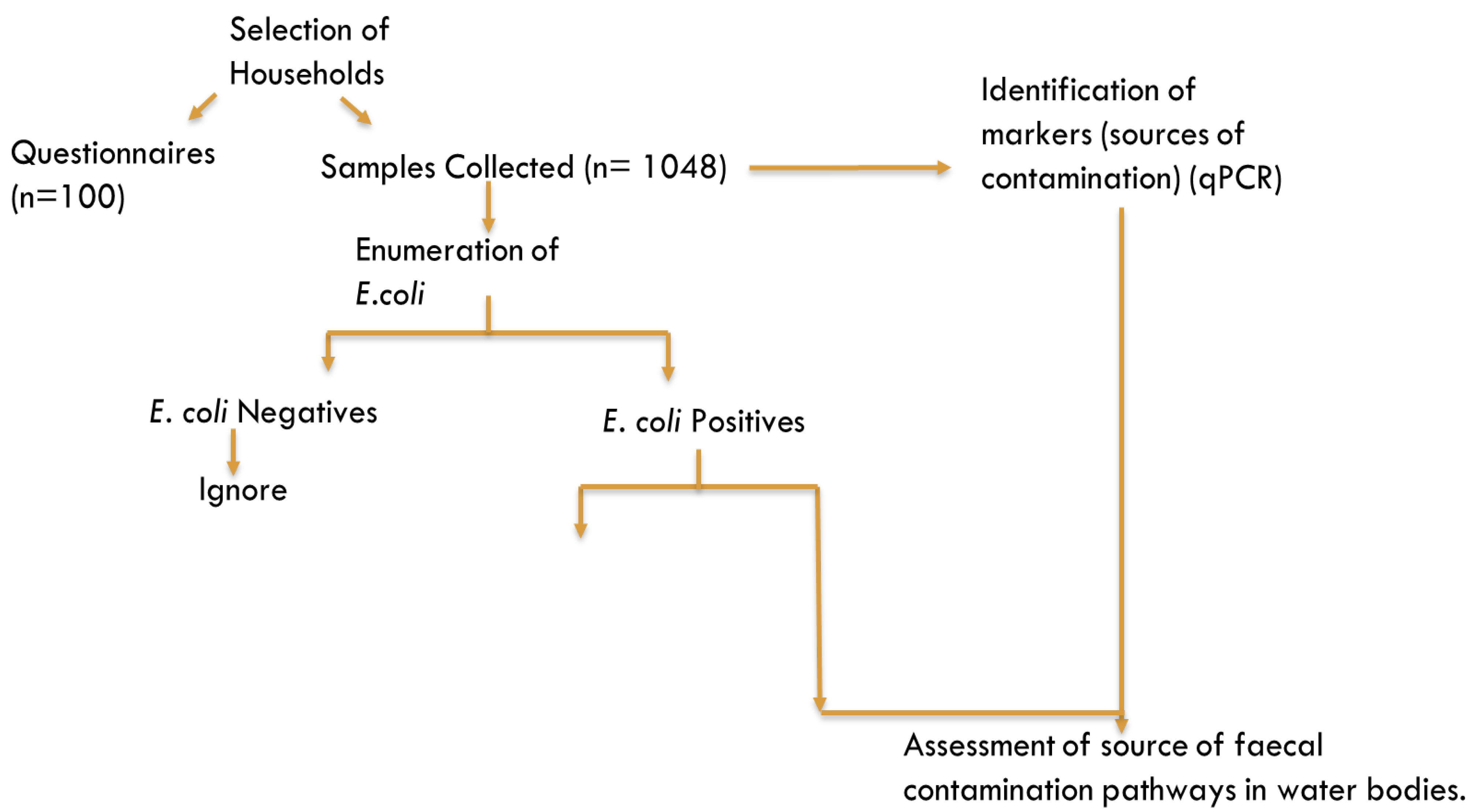
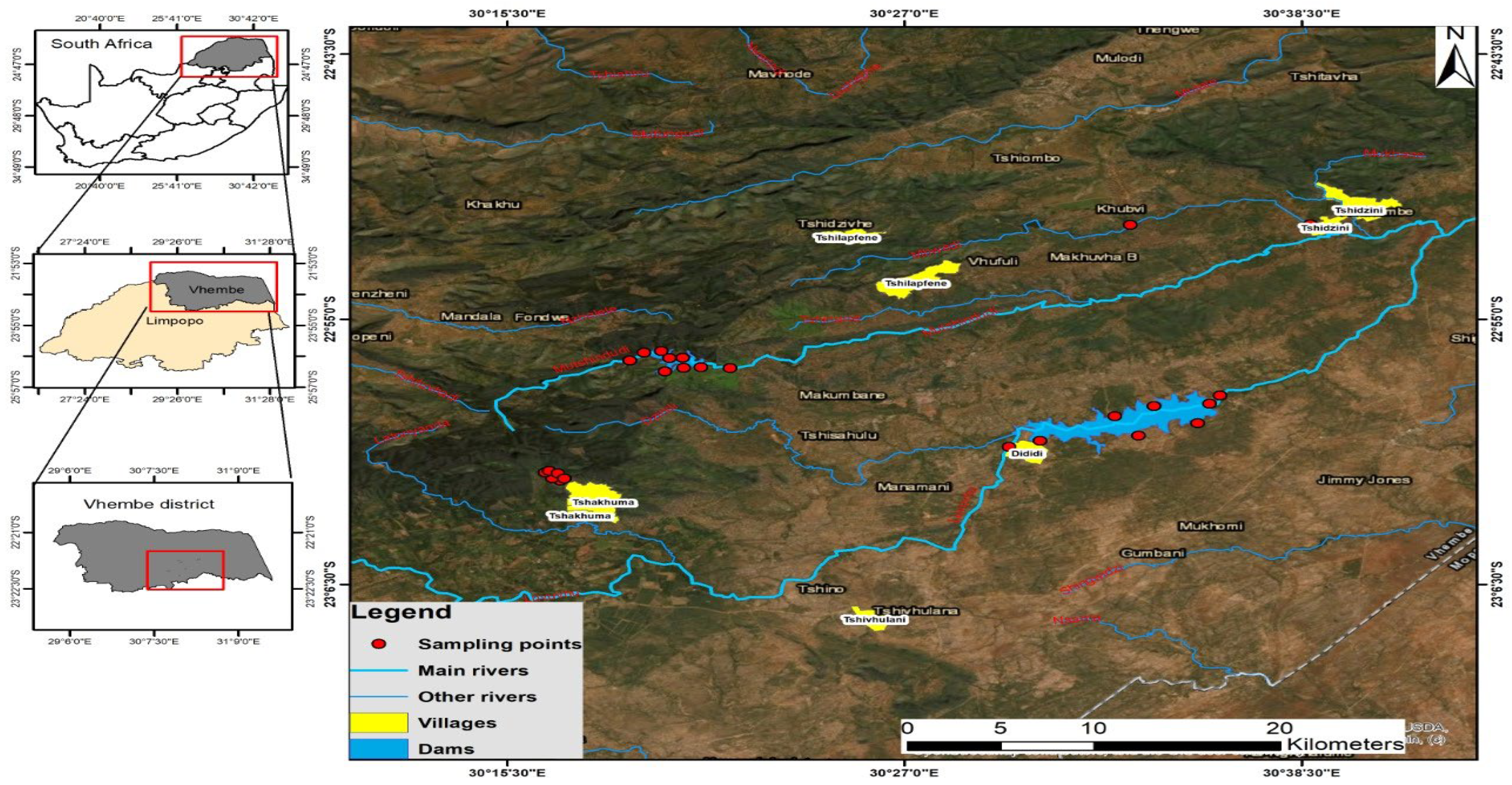


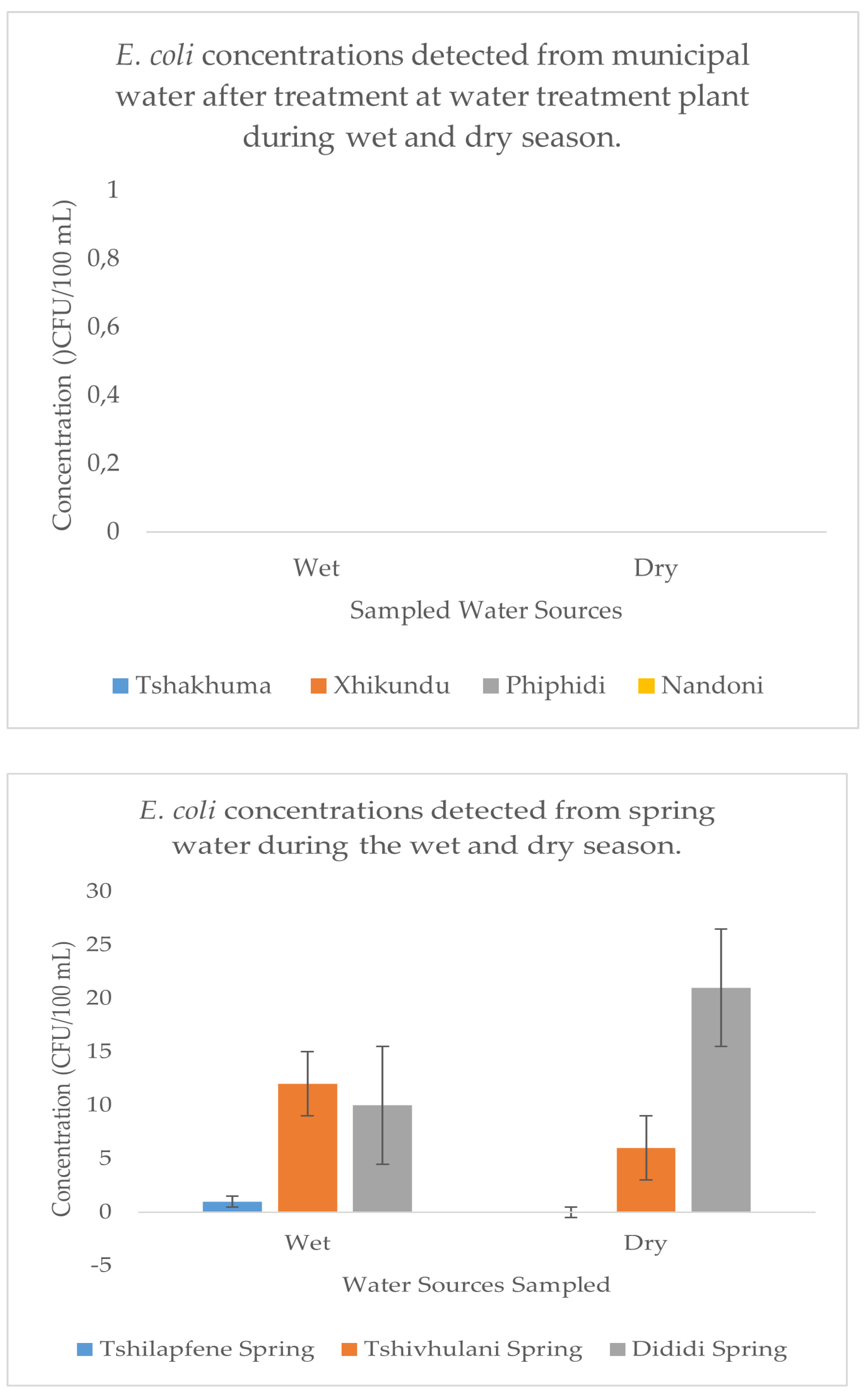
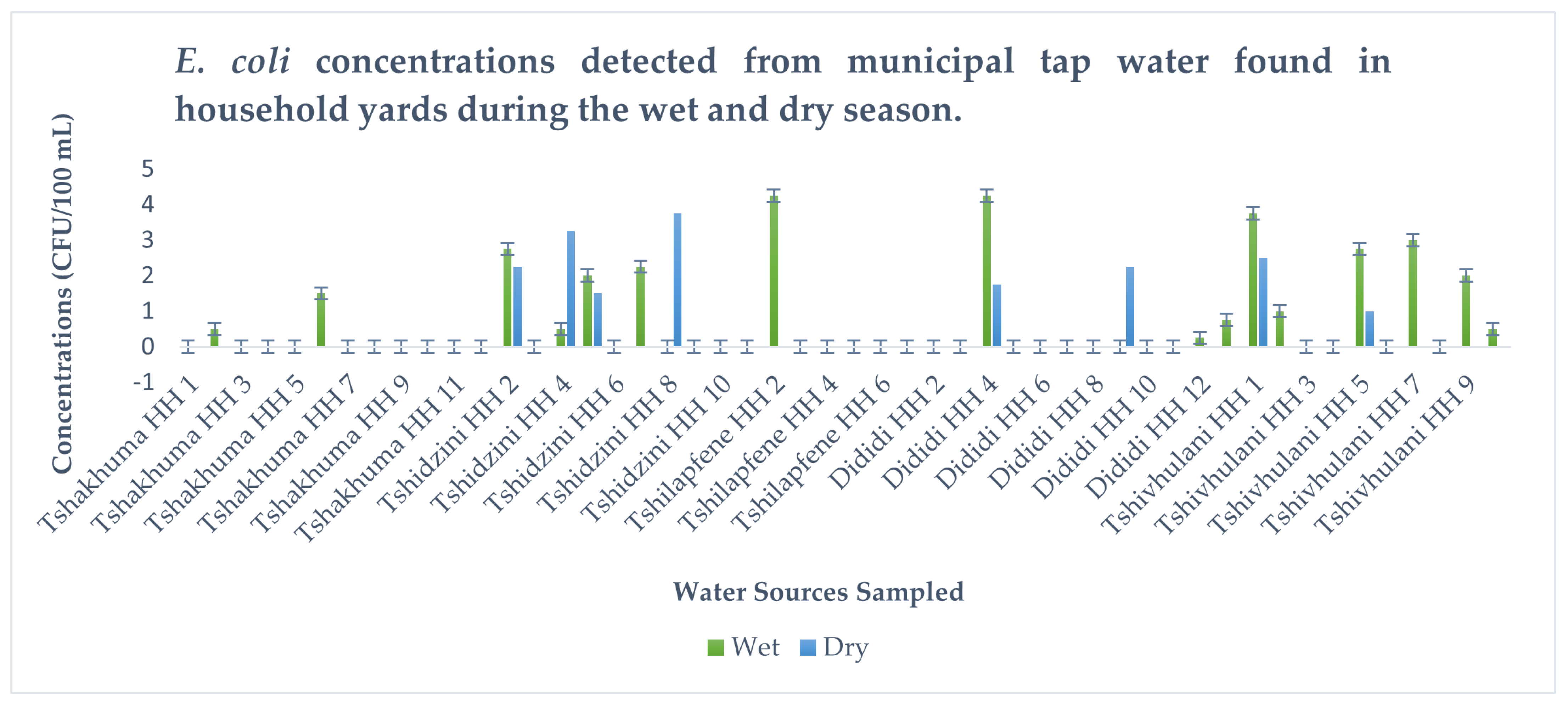

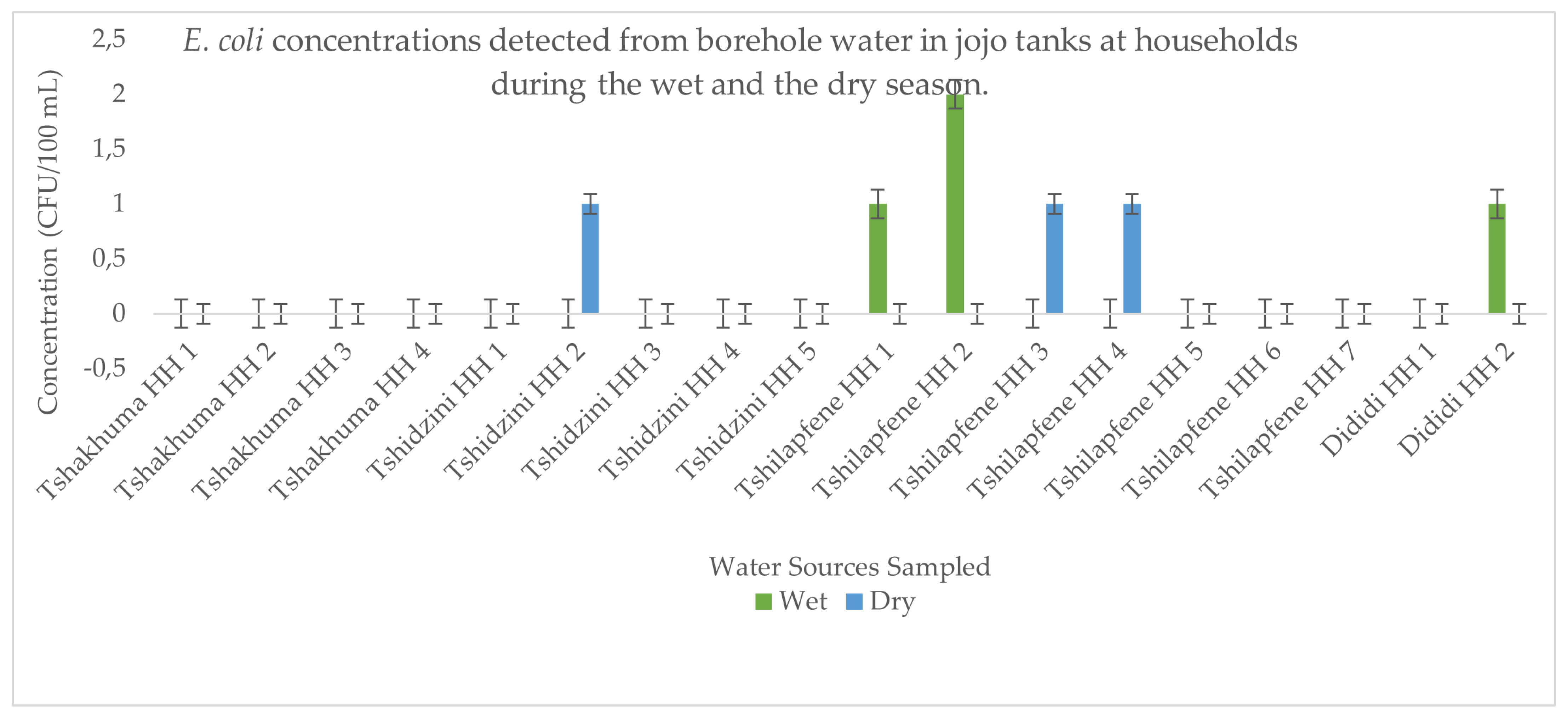

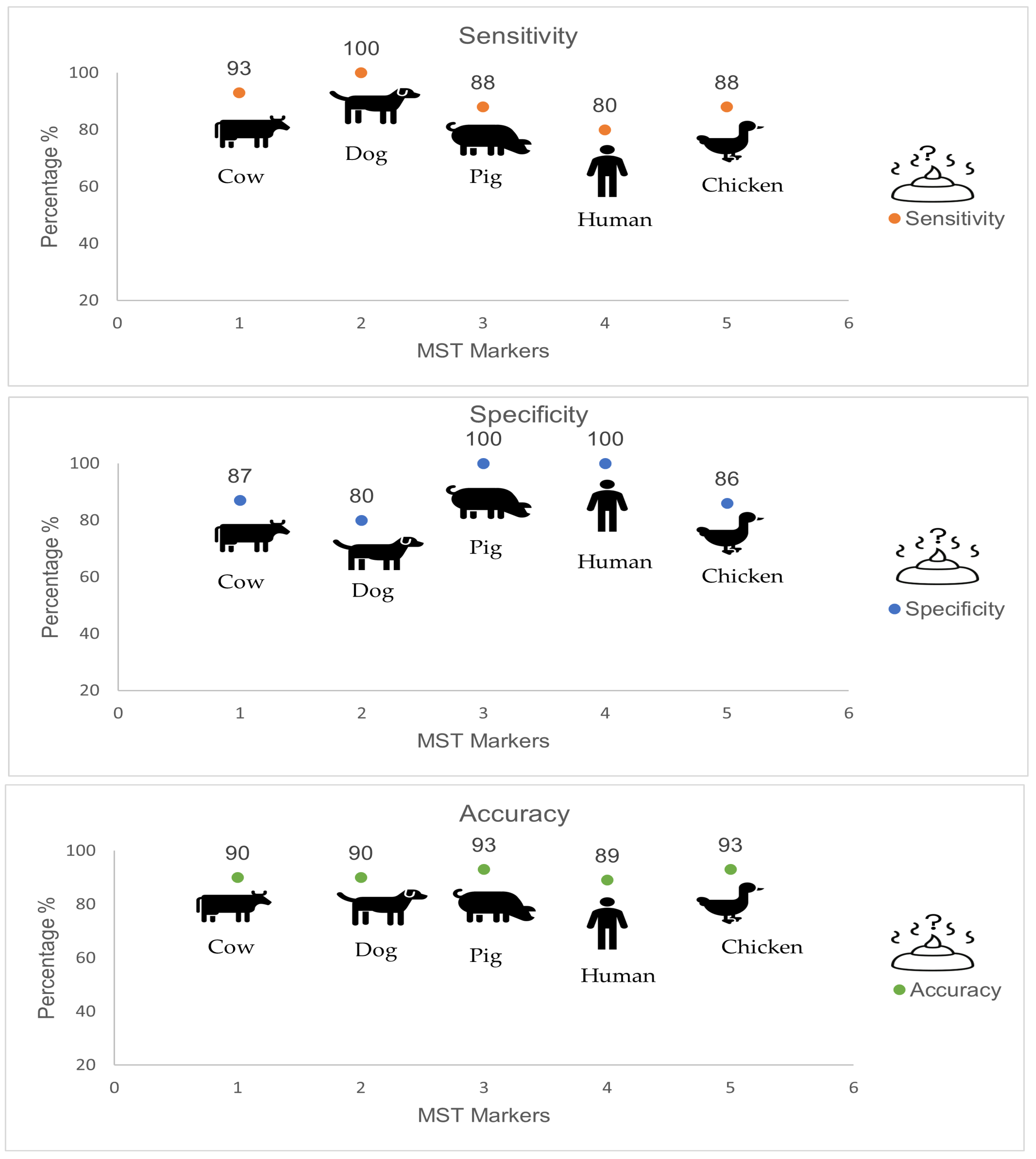
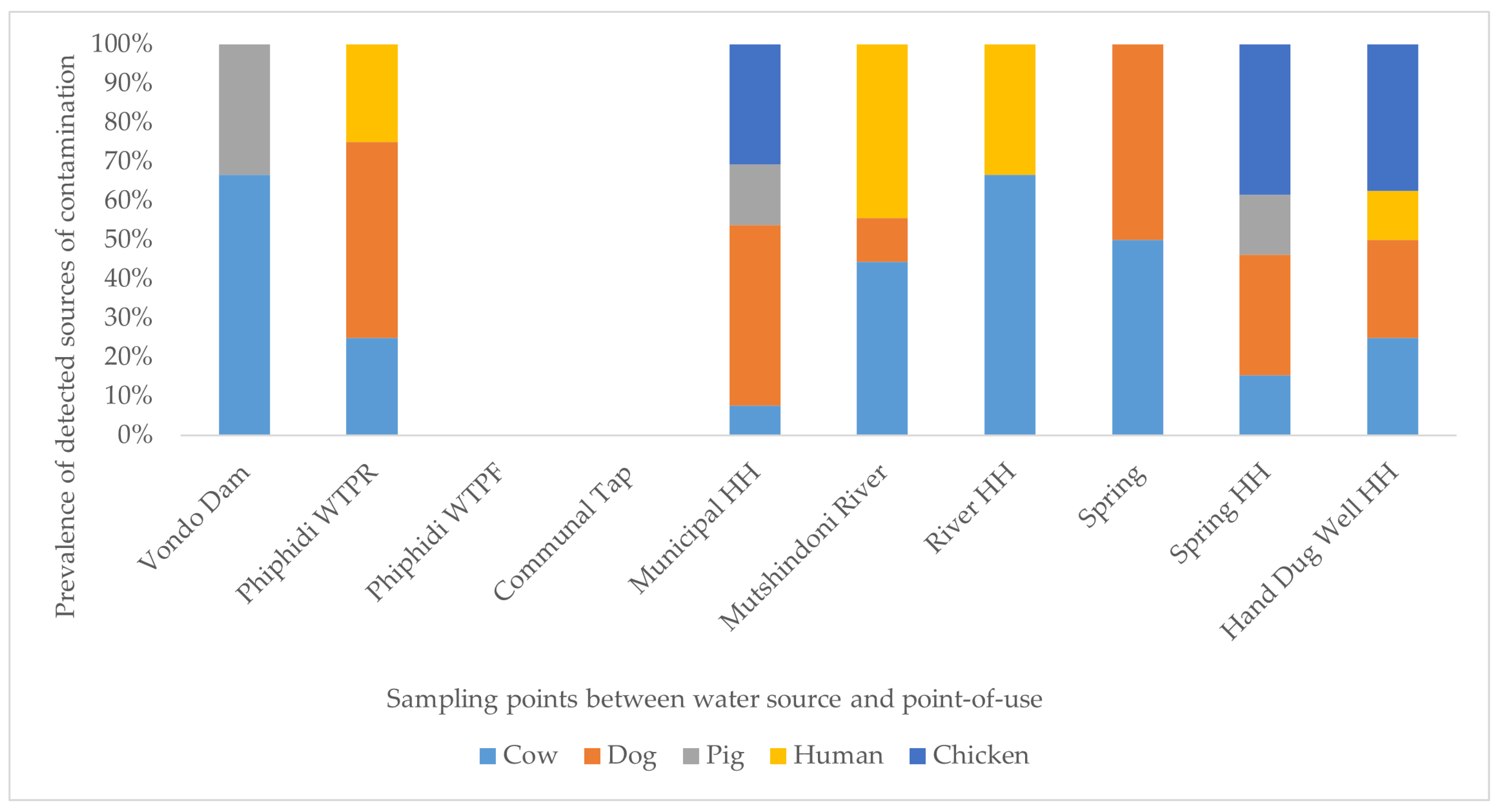
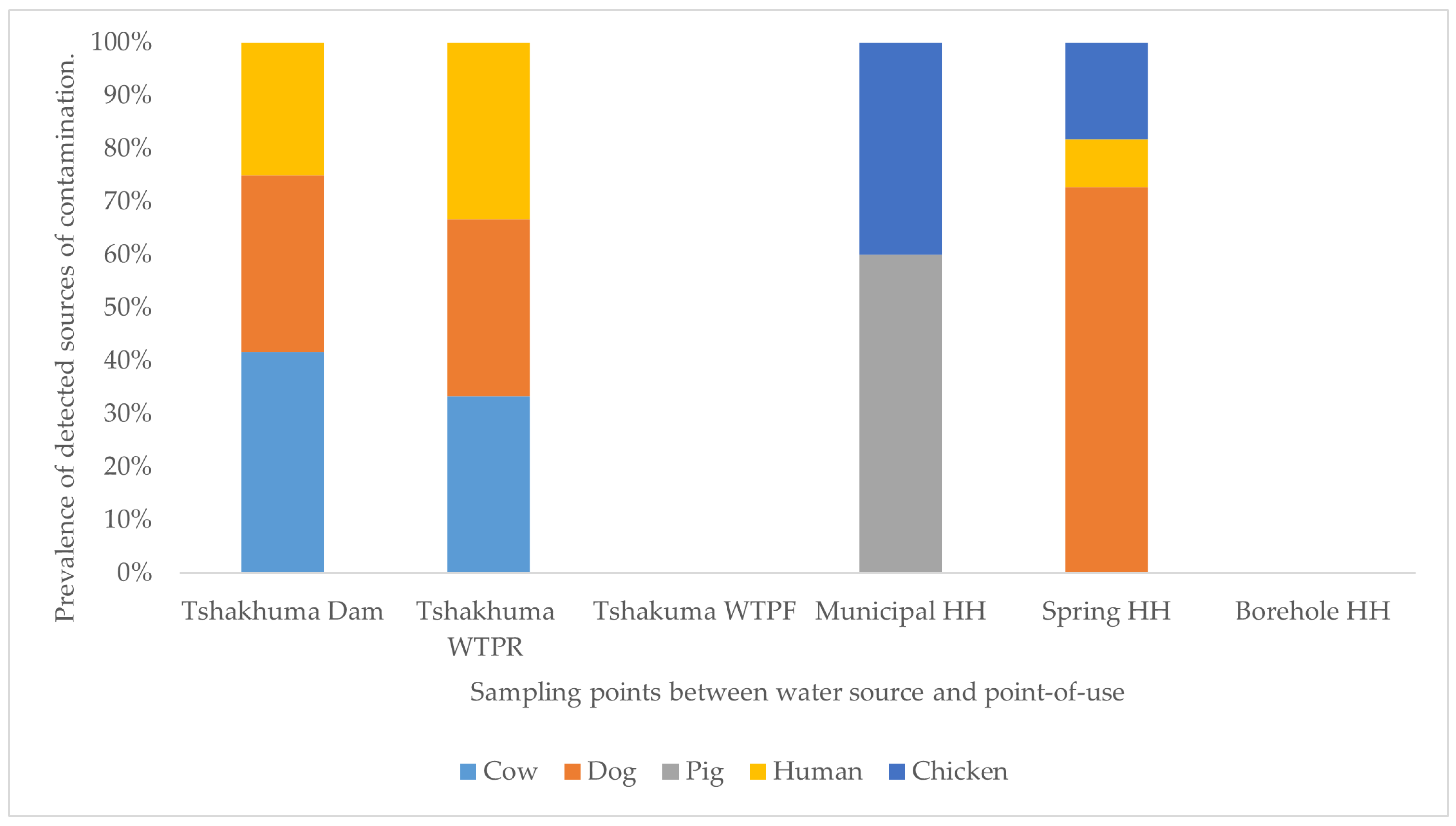
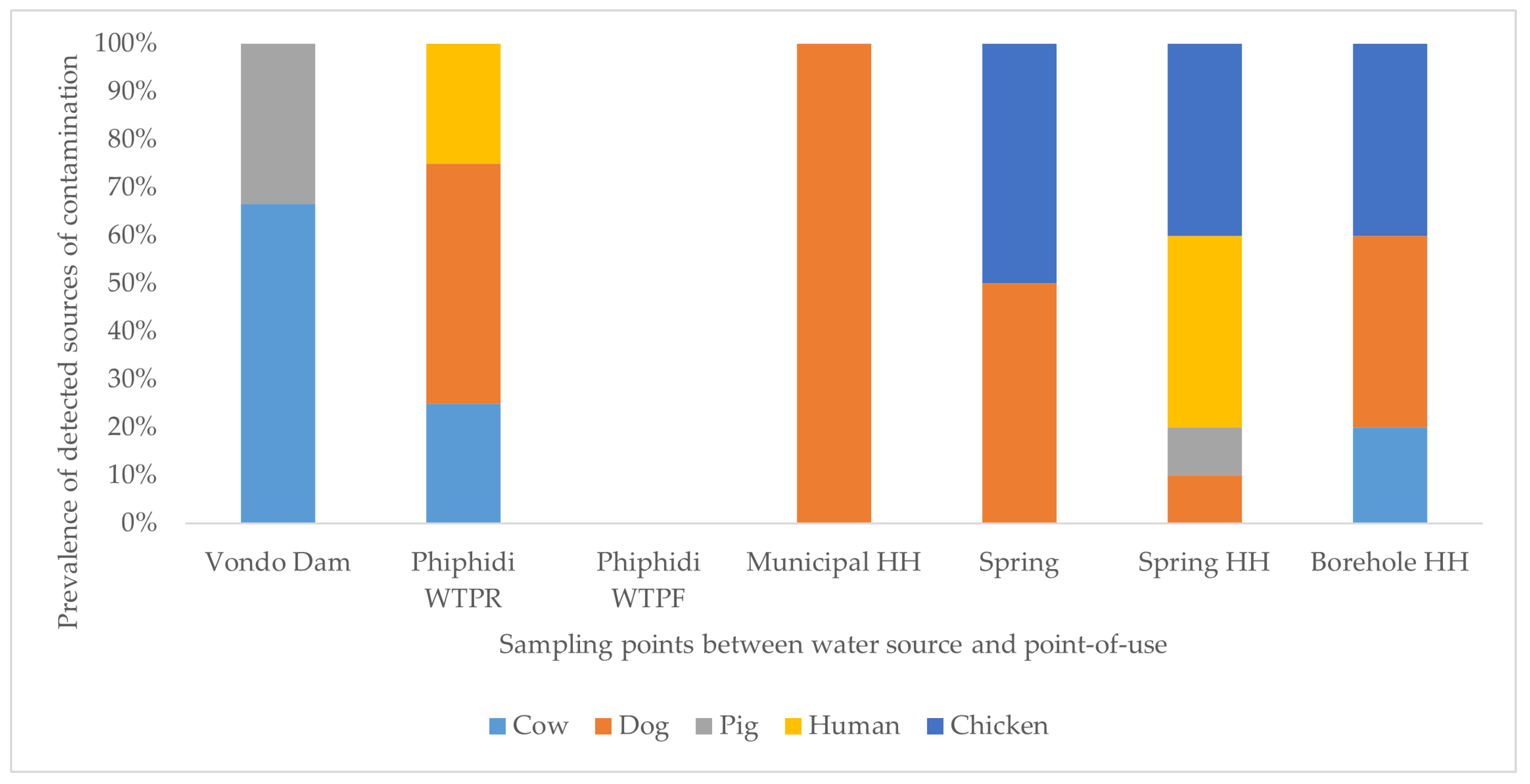
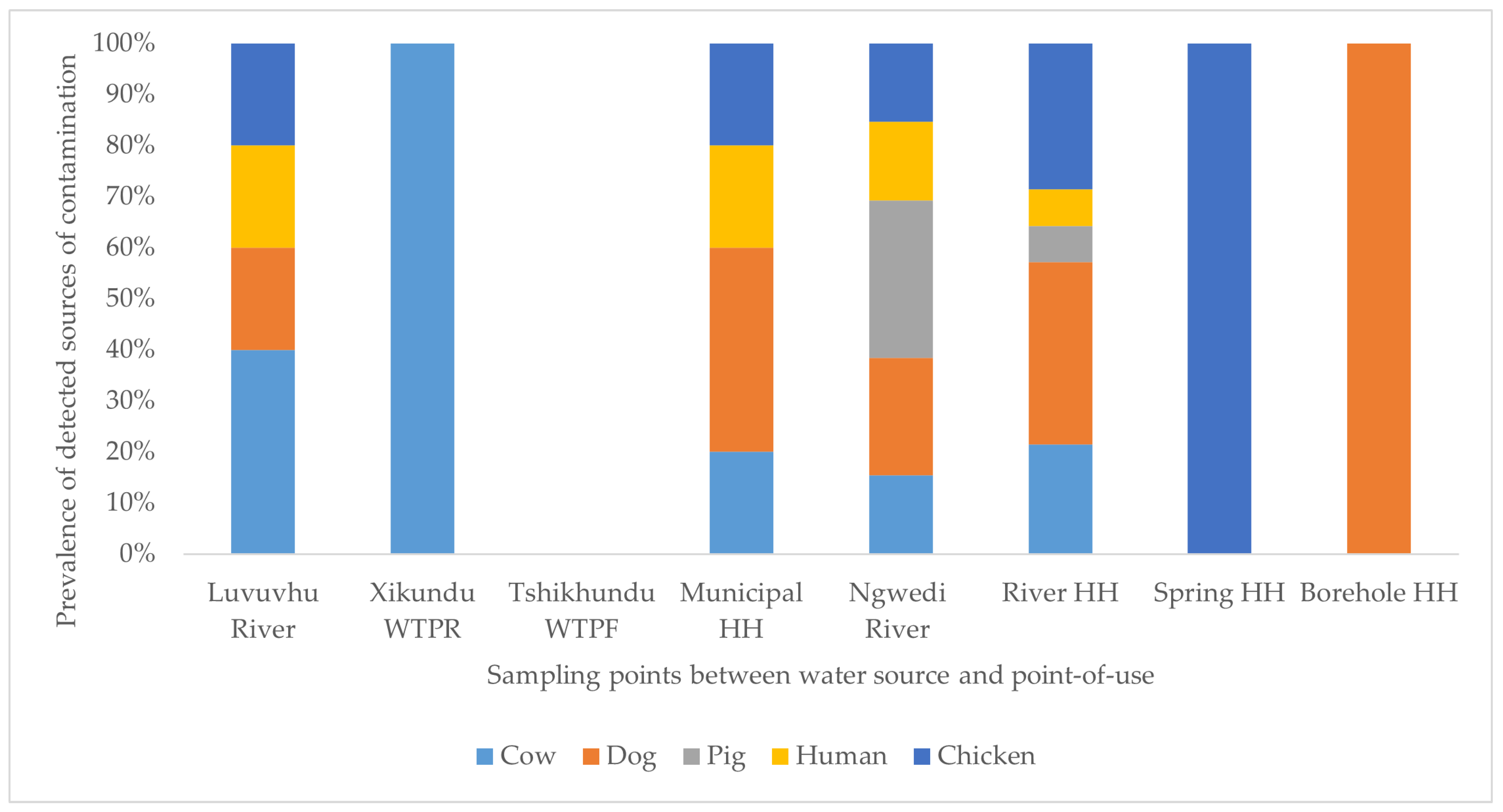

| Host | Target Name | Sequence (5′-3′) | Dye | Reference |
|---|---|---|---|---|
| Human | HF183–1 | ATCATGAGTTCACATGTCCG | FAM-TAMRA | Kapoor et al., 2015 [14] |
| BthetR1 | CGTAGGAGTTTGGACCGTGT | |||
| BthetP1 | CTGAGAGGAAGGTCCCCCACATTGGA | |||
| Cow | BacCow-CF128 | CCAACYTTCCCGWTACTC | FAM-TAMRA | Kildare et al., 2007 [11] |
| BacCow-305r | GGACCGTGTCTCAGTTCCAGTG | |||
| BacCow-257p | TAGGGGTTCTGAGAGGAAGGTCCCCC | |||
| Pig | Pig-2-Bac41F | GCATGAATTTAGCTTGCTAAATTTGAT | FAM-MGB | Mieszkin et al., 2009 [15] |
| Pig-2-Bac R | ACCTCATACGGTATTAATCCGC | |||
| Pig-2-Bac113 | TCCACGGGATAGCC | |||
| Chicken | Cytb F | AAATCCCACCCCCTACTAAAAATAAT | FAM-MGB | Schiaffino et al., 2020 [30] |
| Cytb R | CAGATGAAGAAGAATGAGGCG | |||
| Cytb P | ACAACTCCCTAATCGACCT | |||
| Dog | BacCan1545f | GGAGCGCAGACGGGTTTT | FAM-MGB | Kildare et al., 2007 [11] |
| BacUni-690r1 | CAATCGGAGTTCTTCGTGATATCTA | |||
| BacUni-656p | TGGTGTAGCGGTGAAA |
| Water Source | Wet Season | Dry Season | p-Value | ||||||
|---|---|---|---|---|---|---|---|---|---|
| Mean SD | Min | Max | df | Mean SD | Min | Max | df | ||
| Catchments (RD) (n = 96) | 45 ± 30.69 | 8 | 90 | 79 | 22 ± 15.05 | 6 | 50 | 79 | 0.01 |
| RWPT (n = 40) | 35 ± 17.91 | 12 | 60 | 31 | 19 ± 16.96 | 8 | 48 | 31 | 0.01 |
| MTWPT (n = 40) | 0 | 0 | 0 | 31 | 0 | 0 | 0 | 31 | 0.00 |
| Communal tap (n = 8) | 0 | 0 | 0 | 7 | 0 | 0 | 0 | 7 | 0.00 |
| MTWHHY (n = 400) | 0.64 ± 1.20 | 0 | 4 | 399 | 0.37 ± 0.90 | 0 | 4 | 399 | 0.02 |
| SW (n = 24) | 8 ± 4.87 | 1 | 10 | 23 | 9 ± 8.58 | 0 | 21 | 23 | 0.08 |
| SWCHH (n = 248) | 2 ± 2.47 | 0 | 8 | 239 | 1.08 ± 1.97 | 0 | 9 | 239 | 0.05 |
| JHHBW (n = 144) | 0.17 ± 0.41 | 0 | 2 | 143 | 0.14 ± 0.28 | 0 | 1 | 143 | 0.05 |
| RWCHH (n = 40) | 22 ± 31.87 | 0 | 85 | 39 | 10 ± 12.14 | 1 | 34 | 39 | 0.03 |
| Standard Curve Parameters for Host-Specific Markers | ||||||||
|---|---|---|---|---|---|---|---|---|
| Target Species | Specific Marker | Slope | y-Intercept | Linearity (R2) | Efficiency (%) | LLOQ (Ct) Value | Gene Copy Number per µL | Log10 Gene Copies per ng |
| Cow | BacCow-CF128 | −3.67 | 40.51 | 0.9925 | 87 | 26.63 | 2.85 × 1037 | 37.45 |
| Chicken | Cytb | −3.75 | 39.62 | 0.9926 | 85 | 26.51 | 1.18 × 1037 | 37.07 |
| Human | HF183 | −3.74 | 39.84 | 0.9890 | 85 | 26.74 | 2.49 × 1037 | 37.40 |
| Pig | Pig-2-Bac | −3.48 | 39.02 | 0.9783 | 94 | 26.82 | 1.08 × 1038 | 38.03 |
| Dog | BacCan | −3.63 | 39.31 | 0.9931 | 89 | 27.66 | 5.02 × 1038 | 38.70 |
| Sampled Study Villages | Detected Sources of Contamination in All Five Study Villages during the Wet Season | ||||||
|---|---|---|---|---|---|---|---|
| Overall | BacCow (Cow) | Cytb (Chicken) | HF183 (Human) | Pig-2-Bac (Pig) | BacCan (Dog) | p-Value | |
| Tshakhuma (n = 112) | 17 (15%) | 5 (4%) | 3 (3%) | 2 (2%) | 1 (1%) | 8 (7%) | 0.022 |
| Tshivhulani (n = 112) | 28 (25%) | 7 (6%) | 6 (5%) | 3 (3%) | 2 (2%) | 10 (9%) | 0.015 |
| Tshilapfene (n = 96) | 15 (16%) | 4 (4%) | 2 (2%) | 2 (2%) | 2 (2%) | 5 (5%) | 0.030 |
| Tshidzini (n = 104) | 34 (33%) | 8 (8%) | 10 (10%) | 4 (4%) | 3 (3%) | 9 (9%) | 0.019 |
| Dididi (n = 100) | 24 (24%) | 6 (6%) | 5 (5%) | 4 (4%) | 5 (5%) | 4 (4%) | 0.007 |
| Sampled Study Villages | Detected Sources of Contamination in All Five Study Villages during the Dry Season | ||||||
|---|---|---|---|---|---|---|---|
| Overall | BacCow (Cow) | Cytb (Chicken) | HF183 (Human) | Pig-2-Bac (Pig) | BacCan (Dog) | p-Value | |
| Tshakhuma (n = 112) | 13 (11%) | 3 (3%) | 2 (2%) | 2 (2%) | 1 (1%) | 5 (4%) | 0.055 |
| Tshivhulani (n = 112) | 22 (20%) | 6 (5%) | 6 (5%) | 3 (3%) | 2 (2%) | 5 (4%) | 0.031 |
| Tshilapfene (n = 96) | 13 (14%) | 2 (2%) | 3 (3%) | 2 (2%) | 2 (2%) | 4 (4%) | 0.084 |
| Tshidzini (n = 104) | 24 (23%) | 6 (6%) | 4 (4%) | 3 (3%) | 2 (2%) | 9 (9%) | 0.011 |
| Dididi (n = 100) | 21 (21%) | 6 (6%) | 5 (5%) | 3 (3%) | 2 (2%) | 5 (5%) | 0.097 |
| Sampled Water Sources | Detected Source of Faecal Contamination from Different Water Sources in the Study Areas | ||||||
|---|---|---|---|---|---|---|---|
| BacCow (Cow) | Cytb (Chicken) | HF183 (Human) | Pig-2-Bac (Pig) | BacCan (Dog) | p-Value | Pearson Correlation (r) (Wet and Dry Season) | |
| Catchments (R and D) (n = 96) | 25 (26%) | 3 (3%) | 7 (7%) | 6 (6%) | 9 (9%) | 0.002 | 0.47 |
| RWPT (n = 40) | 7 (18%) | 0 (0%) | 2 (5%) | 0 (0%) | 2 (5%) | 0.019 | 0.56 |
| MTWPT (n = 40) | 0 (0%) | 0 (0%) | 0 (0%) | 0 (0%) | 0 (0%) | 0.058 | 0.33 |
| Communal tap (n = 8) | 0 (0%) | 0 (0%) | 0 (0%) | 0 (0%) | 0 (0%) | 0.055 | 0.29 |
| MTWHHY (n = 400) | 4 (1%) | 12 (3%) | 1 (0.3%) | 8 (2%) | 16 (4%) | 0.006 | 0.70 |
| JHHBW (n = 144) | 2 (1%) | 2 (1%) | 0 (0%) | 2 (1%) | 5 (4%) | 0.024 | 0.62 |
| Hand-dug well (n = 8) | 3 (38%) | 2 (25%) | 1 (13%) | 0 (0%) | 4 (50%) | 0.171 | 0.48 |
| RWCHH (n = 40) | 5 (13%) | 0 (0%) | 5 (8%) | 0 (0%) | 0 (0%) | 0.002 | 0.51 |
| SW (n = 24) | 5 (21%) | 1 (4%) | 1 (4%) | 1 (4%) | (21%) | 0.037 | 0.87 |
| SWCHH (n-248) | 2 (1%) | 14 (6%) | 4 (2%) | 7 (3%) | 17 (7%) | 0.011 | 0.22 |
| Correlation Coefficient (r) | ||||||||||
|---|---|---|---|---|---|---|---|---|---|---|
| WET | E. coli | BacCow | E. coli | Cytb | E. coli | BacCan | E. coli | HF183 | E. coli | Pig-2-Bac |
| E. coli | 1 | |||||||||
| BacCow | 0.93 | 1 | ||||||||
| E. coli | 1 | 0.93 | 1 | |||||||
| Cytb | 0.90 | 0.95 | 0.90 | 1 | ||||||
| E. coli | 1 | 0.93 | 1 | 0.90 | 1 | |||||
| BacCan | 0.43 | 0.40 | 0.43 | 0.52 | 0.43 | 1 | ||||
| E. coli | 1 | 0.93 | 1 | 0.90 | 1 | 0.43 | 1 | |||
| HF183 | 0.70 | 0.85 | 0.70 | 0.77 | 0.70 | −0.10 | 0.70 | 1 | ||
| E. coli | 1 | 0.93 | 1 | 0.90 | 1 | 0.43 | 1 | 0.70 | 1 | |
| Pig-2-Bac | 0.35 | 0.50 | 0.35 | 0.35 | 0.35 | −0.58 | 0.35 | 0.86 | 0.35 | 1 |
| Correlation Coefficient (r) | ||||||||||
|---|---|---|---|---|---|---|---|---|---|---|
| DRY | E. coli | BacCow | E. coli | Cytb | E. coli | BacCan | E. coli | HF183 | E. coli | Pig-2-Bac |
| E. coli | 1 | |||||||||
| BacCow | 0.64 | 1 | ||||||||
| E. coli | 1 | 0.64 | 1 | |||||||
| Cytb | 0.54 | 0.79 | 0.54 | 1 | ||||||
| E. coli | 1 | 0.64 | 1.00 | 0.54 | 1 | |||||
| BacCan | 0.70 | 0.53 | 0.70 | 0.09 | 0.70 | 1 | ||||
| E. coli | 1 | 0.64 | 1 | 0.54 | 1.00 | 0.70 | 1 | |||
| HF183 | 0.63 | 0.95 | 0.63 | 0.86 | 0.63 | 0.52 | 0.63 | 1 | ||
| E. coli | 1.00 | 0.64 | 1 | 0.54 | 1 | 0.70 | 1 | 0.63 | 1 | |
| Pig-2-Bac | 0.41 | 0.39 | 0.41 | 0.67 | 0.41 | 0.22 | 0.41 | 0.65 | 0.41 | 1 |
Disclaimer/Publisher’s Note: The statements, opinions and data contained in all publications are solely those of the individual author(s) and contributor(s) and not of MDPI and/or the editor(s). MDPI and/or the editor(s) disclaim responsibility for any injury to people or property resulting from any ideas, methods, instructions or products referred to in the content. |
© 2024 by the authors. Licensee MDPI, Basel, Switzerland. This article is an open access article distributed under the terms and conditions of the Creative Commons Attribution (CC BY) license (https://creativecommons.org/licenses/by/4.0/).
Share and Cite
Mochware, O.T.W.; Thaoge-Zwane, M.L.; Momba, M.N.B. Applying Microbial Source Tracking Techniques for Identification of Pathways of Faecal Pollution from Water Sources to Point of Use in Vhembe District, South Africa. Water 2024, 16, 2014. https://doi.org/10.3390/w16142014
Mochware OTW, Thaoge-Zwane ML, Momba MNB. Applying Microbial Source Tracking Techniques for Identification of Pathways of Faecal Pollution from Water Sources to Point of Use in Vhembe District, South Africa. Water. 2024; 16(14):2014. https://doi.org/10.3390/w16142014
Chicago/Turabian StyleMochware, Opelo Tlotlo Wryl, Mathoto Lydia Thaoge-Zwane, and Maggy Ndombo Benkete Momba. 2024. "Applying Microbial Source Tracking Techniques for Identification of Pathways of Faecal Pollution from Water Sources to Point of Use in Vhembe District, South Africa" Water 16, no. 14: 2014. https://doi.org/10.3390/w16142014
APA StyleMochware, O. T. W., Thaoge-Zwane, M. L., & Momba, M. N. B. (2024). Applying Microbial Source Tracking Techniques for Identification of Pathways of Faecal Pollution from Water Sources to Point of Use in Vhembe District, South Africa. Water, 16(14), 2014. https://doi.org/10.3390/w16142014








